NINE DEAD... hundreds injured... 45,000 left homeless... $200 million in damage... the work of 17 years completely wiped out in one night.
This is what Typhoon Karen did when her 200 MPH winds ripped through the Mid-Pacific island of Guam last November, leaving a wake of wreckage and debris.
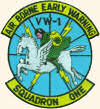
Despite this devastating scene, the 76,000 civilian and military residents of the small island could be considered lucky as only nine of their number had been killed during the storm.
Officials on the island claim that if Guam had not received a three-day warning of Karen's approach many more would have perished.
As it was, Guam had gone into full typhoon alert hours before the storm struck. Most of the islanders had complied with typhoon precautionary measures and were safely sheltered inside typhoon-proof buildings before the storm hit. This is how heavy casualties were avoided.
ACCORDING to the Joint Typhoon Warning Center on Guam, the key to their success in issuing accurate and timely warnings prior to the storm was aerial weather reconnaissance.
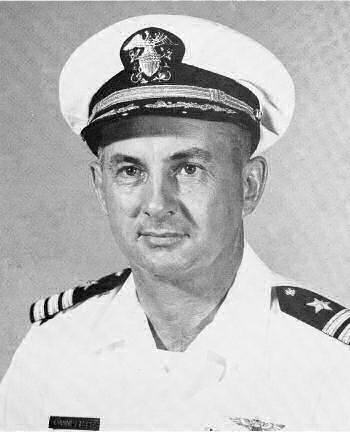 CDR. Ralph Dannettell jr. CO AEW sq. 1
CDR. Ralph Dannettell jr. CO AEW sq. 1(U.S. Navy Photo)
Shouldering a large share of the resposibility for the storm air reconnaissance in the Western Pacific are the Navy "Typhoon Trackers" of Airborne Early Warning Squadron One (VW-1), home based at Agana Naval Air Station, Guam.
This unique squadron, the only Navy weather air reconnaissance group in the Pacific area, was alerted by JTWC three days before Karen hit the island.
These Navy men, flying the radar-equipped and weather-instrumented early warning plane Warning Star EC-121K (WV-2) immediately took off from Agana after being alerted.
Upon arrival in the Truk-Ponape area, some 500 miles southeast of Guam, the plane's weather and radar crews went into action. Weather conditions such as wind direction and velocity, temperature, humidity and barometric pressure were measured by the group. The exact location of the storm's eye was also plotted.
Observations were made on the plane's radar gear of the storm pattern and recorded on film.
Knowing that they had a big storm on their hands this time, the radio crew quickly wired the vital information back to Joint Typhoon Warning Center which began issuing storm warnings Nov. 8.
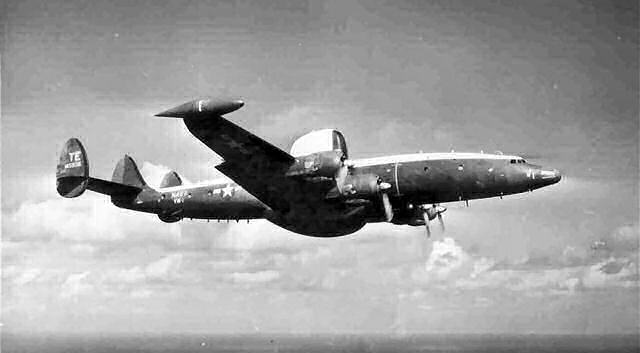 ... THIS IS THE PLANE ... a Warning Star, one of the squadrons planes. Radar equiped and
weather instrumented, it can penetrate the eye of the typhoon to gather data which helps it determine
the storm's power.
... THIS IS THE PLANE ... a Warning Star, one of the squadrons planes. Radar equiped and
weather instrumented, it can penetrate the eye of the typhoon to gather data which helps it determine
the storm's power.
As the typhoon neared Guam, VW-1 continued to fly reconnaissance missions on Karen. Because the Navy squadron possesses special radar gear capable of tracking storms at night, VW-1 flew all missions after dark as well as supporting the weather squadron on Guam during the day.
INFORMATION gained through air reconnaissance continued to flow into the center and soon it was apparent to weather technicians on Guam that their worst expectations would be realized. The island would be hit by the most powerful typhoon in her history.
Sunday morning, Nov. 11, typhoon alert condition-one was released by the center. the military and civilian population of the island immediately began to prepare for the worse.
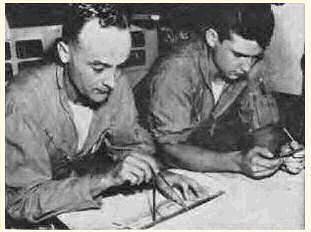 THESE ARE THE MEN. Lcdr. John W. Kidd (left) senior weather reconnaissance officer of
the squadron and an enlisted aerographers mate fix time and determine position, speed, course, velocity
and other data.
THESE ARE THE MEN. Lcdr. John W. Kidd (left) senior weather reconnaissance officer of
the squadron and an enlisted aerographers mate fix time and determine position, speed, course, velocity
and other data.
Houses were bolted, loose equipment brought inside, cars locked in garages, and supplies brought to typhoon-proof buildings where residents would wait out the storm.
VW-1 also began preparing for the onslaught. All squadron planes were flown out of Guam and temporarily based at Subic Bay, Philippines. That is all but one plane and its crew which remained in the squadron hanger.
When the storm struck that evening at eight o'clock, a VW-1 search plane was hovering high above Guam observing Karen. As the typhoon swept across the island, the plane's crew watched helplessly knowing that wives, families and friends were down there riding out the storm.
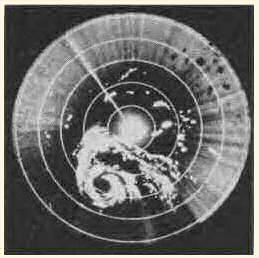 ... AND THIS IS THE STORM... the eye of Typhoon Olive, which passed Guam earlier this
year, is located on the plane's radar scope.
... AND THIS IS THE STORM... the eye of Typhoon Olive, which passed Guam earlier this
year, is located on the plane's radar scope.(USN Photo)
By 9 p.m. winds had increased from 58 to 200 MPH as the eye of the sorm passed over Agana NAS. Next morning at seven, winds had begun to subside and were back down to 58 MPH.
Although the island was now nothing more than a heap of rubble the VW-1 seach plane which had been left in the squadron hanger was unharmed.
Damage to squadron buildings and equipment was extensive, but those who had stayed behind quickly set to work repairing what remainded. Within four days VW-1 launched the remaining aircraft to insure that no tropical disturbance followed Karen's wake. Nothing was found, and reconstruction on Guam progressed.
The weather surveys made on Typhoon Karen demonstrate why the men of Reconnaissance Squadron One find little rest during the typhoon season months of July through November.
Just a few weeks ago, the Navy's Typhoon Trackers were on the alert in the Japan area, keeping a watchful eye on a typhoon. Flying out of Atsugi NAS, Naha AB, and Sangley Point Naval Station, the group continued to transmit vital information to JTWC on Guam and local weather facilities until the storm was safely out of range.
Through the constant vigilance of VW-1, millions in the Far East can rest assured that they will receive advance warning of typhoons and tropical storms, those devastating natural phenomena which have plagued inhabitants of the Western Pacific for centuries.
